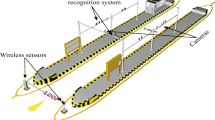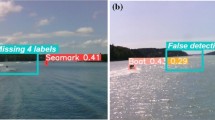Abstract
In the field of global shipping, intelligent container code recognition has become a popular research topic. To address the issues of poor recognition accuracy and real-time performance in the complex port environment, this paper proposes a real-time container code recognition method based on YOLOV5. The proposed method consists of two stages: container code localization and container code recognition. First, for container code localization, the backbone component consists of MobileOne blocks to enhance feature extraction capability and accelerate inference speed. Second, for container code recognition, a lightweight MobileNetV3 is used as the backbone. Third, a feature extraction module, called Multiple Reuse Feature Pyramid Networks (MRFPN), is designed to extract sufficient semantic information. Experimental results show that the algorithm achieves accuracy rates of 96.5% and 93.5% in the container code localization and container code recognition stages, respectively, while significantly reducing the number of parameters, computations, and model size, and improving inference speed. Additionally, the proposed method performs better in terms of real-time performance and can meet the requirements of practical applications.

















Similar content being viewed by others
Data availability
The data that support the fndings of this study are available from the corresponding author, [Guanghui Wang], upon reasonable request.
References
Zhang, K., Sheng, L., Liu, G., et al.: Overview of the development of container number identification system in container terminals. Port Operation (2022). https://doi.org/10.3963/j.issn.1000-8969.2022.02.014
Zhang, S., Mao, Y., Wang, J., Feng, T.: Container code recognition from images with large perspective deformation. J Tongji Univer Nat Sci (2019). https://doi.org/10.11908/j.issn.0253-374x.2019.02.018
Redmon, J., Divvala, S., Girshick, R., et al. (2016) You only look once: Unified, real-time object detection. In: Proceedings of the IEEE Conference on Computer Vision and Pattern Recognition. https://doi.org/10.48550/arXiv.1506.02640
Redmon, J., Farhadi, A.: YOLO9000: better, faster, stronger. In: Proceedings of the IEEE Conference on Computer Vision and Pattern Recognition, pp. 7263–7271 (2017). https://doi.org/10.48550/arXiv.1612.08242
Redmon, J., Farhadi, A.: Yolov3: An incremental improvement. arXiv preprint arXiv: 1804.02767 (2018). https://doi.org/10.48550/arXiv.1804.02767
Bochkovskiy, A., Wang, C.-Y., et al.: Yolov4: Optimal speed and accuracy of object detection. arXiv preprint arXiv:2004.10934 (2020). https://doi.org/10.48550/arXiv.2004.10934
Vasu, P., Gabriel, J., Zhu, J., et al.: An improved one millisecond mobile backbone. arXiv preprint arXiv:2206.04040 (2022). https://doi.org/10.48550/arXiv.2206.04040
Howard, A., Sandler, M., Chu, G., et al.: Searching for mobilenetv3. In: Proceedings of the IEEE/CVF international conference on computer vision, pp. 1314–1324 (2019). https://doi.org/10.48550/arXiv.1905.02244
Jiang, L.: Research on Container Positioning and Box Number Identification Technology Based on Image Processing. Southwest Jiaotong University (2019)
Zhang, C., Li, X.: Application of Gray-level Hybrid Method in Recognition of Container Number. Computer and Modernization. 05: 41–45 (2019). http://www.cqvip.com/qk/97264x/201905/7001928319.html
Ma, X., Li, X.: Research on key technologies for character recognition of container numbers. Modern Electronic Technology. 42(14):131–134+139(2019). https://kns.cnki.net/kcms/detail/detail.aspx?FileName=JYXH201905010&DbName=CJFQ2019
Chen, C., Niu, W., Du, F.: Research on key technologies for character recognition of container numbers. Journal of Shanghai Maritime University. 01: 65–70 (2019). https://kns.cnki.net/kcms/detail/detail.aspx?FileName=SHHY201901011&DbName=CJFQ2019.
Sun, Y., Li, X.: Application of Ant Colony Optimization Algorithm in Container Number Locating. Modern Computer. 13: 54–58 (2018). https://kns.cnki.net/kcms/detail/detail.aspx?FileName=XDJS201813013&DbName=CJFQ2018
Liu, W., He, J., et al.: Relocation of the Container Characters Based on the Connected Domain. Computer Knowledge and Technology. 09, 260–261(2016). https://kns.cnki.net/kcms/detail/34.1205.tp.20160516.0836.178.html
Liu, C., Guo, L., et al.: Application of improved YOLOv3 algorithm in container number localization. Transducer and Microsystem Technologies. 07: 157–160 (2019). https://kns.cnki.net/kcms/detail/23.1537.TN.20190626.1005.045.html
Hou, J.: Research on port container number recognition system based on image enhancement. Zhejiang Ocean University (2022)
Cui, X.: University of Electronic Science and Technology of China. Changchun University of Science and Technology (2020)
Li, C., Liu, S., Xia, Q., et al.: Automatic container code localization and recognition via an efficient code detector and sequence recognition. 2019 IEEE/ASME International Conference on Advanced Intelligent Mechatronics (AIM), IEEE, 532–537 (2019). https://doi.org/10.1109/AIM.2019.8868819
Wang, Z., Wang, Y.: FRCA: High-efficiency container number detection and recognition algorithm with enhanced attention. In: Eleventh International Conference on Graphics and Image Processing (ICGIP 2019), SPIE, 11373: 35–45 (2020). https://doi.org/10.1117/12.2557197
Wang, H., Jin, Y., Ke, H., et al.: DDH-YOLOv5: improved YOLOv5 based on Double IoU-aware Decoupled Head for object detection. Journal of Real-Time Image Processing, 1–11 (2022). https://doi.org/10.1007/s11554-022-01241-z
Mauri, A., Khemmar, R., Decoux, B., et al.: Lightweight convolutional neural network for real-time 3D object detection in road and railway environments. J. Real-Time Image Proc. 19(3), 499–516 (2022). https://doi.org/10.1007/s11554-022-01202-6
Ding, X., Zhang, X., Han, J., et al.: Diverse branch block: Building a convolution as an inception-like unit. In: Proceedings of the IEEE/CVF Conference on Computer Vision and Pattern Recognition, 10886–10895 (2021). https://doi.org/10.48550/arXiv.2103.13425.
Yang, G., Song, C., Yang, Z., et al.: Bubble detection in photoresist with small samples based on GAN augmentations and modified YOLO. Eng. Appl. Artif. Intell. 123, 106224 (2023). https://doi.org/10.1016/j.engappai.2023.106224
Ding, X., Zhang, X., Han, J., et al.: Scaling up your kernels to 31x31: Revisiting large kernel design in cnns. In: Proceedings of the IEEE/CVF Conference on Computer Vision and Pattern Recognition, 11963–11975 (2022). https://doi.org/10.48550/arXiv.2203.06717
Ren, S., He, K., Girshick, R., et al.: Faster r-cnn: Towards real-time object detection with region proposal networks. Adv. neural inf. process. Syst,28 (2015). https://doi.org/10.1109/TPAMI.2016.2577031
Chen, Q., Wang, Y., Yang, T., et al.: You only look one-level feature. In: Proceedings of the IEEE/CVF Conference on Computer Vision and Pattern Recognition, 13039–13048 (2021). https://doi.org/10.48550/arXiv.2103.09460
Lin, T., Dollár, P., Girshick, R., et al.: Feature pyramid networks for object detection. In: Proceedings of the IEEE Conference on Computer Vision and Pattern Recognition, 2117–2125 (2017). https://doi.org/10.48550/arXiv.1612.03144
Quan, Y., Zhang, D., Zhang, L., et al.: Centralized Feature Pyramid for Object Detection. arXiv preprint arXiv:2210.02093 (2022). https://doi.org/10.48550/arXiv.2210.02093
Liu, S., Huang, D., Wang, Y.: Learning spatial fusion for single-shot object detection. arXiv preprint arXiv:1911.09516 (2019). https://doi.org/10.48550/arXiv.1911.09516
Mehta, S., Rastegari. M.: Mobilevit: light-weight, general-purpose, and mobile-friendly vision transformer. arXiv preprint arXiv:2110.02178 (2021). https://doi.org/10.48550/arXiv.2110.02178
Acknowledgements
This research was funded by the DIGWAY Industrial Co., Ltd. The authors greatly appreciate the support provided by this company. This research was funded by Major Science and Technology Project of Henan Province, Zhengzhou major scientific and technological innovation special project, and Key scientific research project plan of colleges and universities in Henan Province, under Grant Nos. 201110210300, 2019CXZX0050, and 21A510007.
Author information
Authors and Affiliations
Contributions
DY: Conceptualization, Methodology, Software. GW: Data curation, Writing – original draft, Writing – review and editing. ML and SY: Visualization, Investigation. HZ and XC: Supervision. MZ: Software, Validation.
Corresponding author
Ethics declarations
Conflict of interest
The authors declare that they have no known competing financial interests or personal relationships that could have appeared to influence the work reported in this paper.
Additional information
Publisher's Note
Springer Nature remains neutral with regard to jurisdictional claims in published maps and institutional affiliations.
Rights and permissions
Springer Nature or its licensor (e.g. a society or other partner) holds exclusive rights to this article under a publishing agreement with the author(s) or other rightsholder(s); author self-archiving of the accepted manuscript version of this article is solely governed by the terms of such publishing agreement and applicable law.
About this article
Cite this article
Yang, D., Wang, G., Liu, M. et al. Lightweight container code recognition based on multi-reuse feature fusion and multi-branch structure merger. J Real-Time Image Proc 20, 108 (2023). https://doi.org/10.1007/s11554-023-01364-x
Received:
Accepted:
Published:
DOI: https://doi.org/10.1007/s11554-023-01364-x




